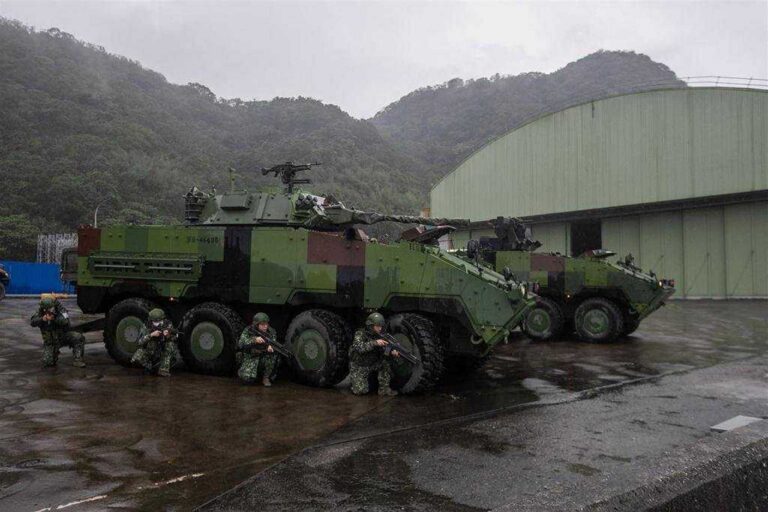Taiwan’s 2nd Mechanized Infantry Battalion Drills for Port Defense Amid Ongoing China Tensions
Taiwan is ramping up its military preparedness amid escalating tensions with China. One of the critical components of this strategy is the intensive training exercised by the 2nd Mechanized Infantry Battalion, which recently conducted drills focused on port defense. With the Taiwan Strait often cited as the most dangerous flashpoint in Asia, these military activities highlight Taiwan’s commitment to safeguarding its territorial integrity.

The Significance of Port Defense
Ports are crucial for Taiwan, not just for trade but also for military logistics. The island’s economy heavily relies on maritime traffic, with over 99% of its trade conducted via sea routes. In a scenario where conflict arises, the ability to defend ports is vital to ensure the uninterrupted flow of resources and military reinforcements. According to the Taiwanese Ministry of National Defense, around 60% of the nation’s population relies directly or indirectly on maritime trade for their livelihood.
Taiwan’s Military Strategy
Taiwan’s military strategy has evolved significantly in recent years, particularly as Chinese military movements grow bolder. Over the past five years, the Chinese military has increased its number of exercises across the Taiwan Strait, with the People’s Liberation Army (PLA) conducting near-daily training missions. Recent statistics indicate that China has expanded its naval fleet to over 350 warships, compared to Taiwan’s approximately 100, underscoring an asymmetry in naval capabilities that necessitates enhanced defense measures.

Given this backdrop, the Taiwanese government has prioritized strengthening both its naval and ground forces. The 2nd Mechanized Infantry Battalion’s drills are part of a broader initiative to prepare for potential maritime incursions, emphasizing rapid deployment and effective coordination with naval assets.
Key Training Exercises
During the recent drills, members of the 2nd Mechanized Infantry Battalion practiced various scenarios, including the quick establishment of defensive positions, vehicle maneuvering, and anti-ship operations. Notably, the exercises included simulations of intercepting enemy vessels attempting to breach port security. With Taiwan hosting one of Asia’s busiest ports, Kaohsiung, the importance of these drills cannot be overstated.

A recent survey by Taiwan’s National Defense University revealed that over 70% of the Taiwanese public supports increased military spending. This surge in public endorsement aligns with ongoing efforts by the Taiwanese government to enhance its defense capabilities, including an upward adjustment of the defense budget to $17 billion for the coming fiscal year.
The Role of Technology
In addition to traditional military exercises, the Taiwanese military aims to incorporate advanced technologies into its training regimen. Drones and surveillance systems are increasingly being utilized for reconnaissance and intelligence-gathering operations, enabling more effective and timely responses to threats. According to military insiders, Taiwan has invested heavily in asymmetric warfare strategies and high-tech weaponry to counterbalance the PLA’s numerical superiority.

Regional Implications
The ongoing military drills by Taiwanese forces also have regional implications. The U.S. government has expressed its support for Taiwan’s self-defense capabilities, conducting joint exercises and selling military equipment to the island. In a recent statement, a Pentagon spokesperson emphasized the U.S.’s commitment to assist Taiwan in maintaining its military readiness against external threats. Consequently, Taiwan’s military posture is not merely a domestic concern but has reverberations throughout the Indo-Pacific region.
Conclusion
Taiwan’s recent drills by the 2nd Mechanized Infantry Battalion serve as a clear signal of its preparedness amid rising tensions with China. The strategic focus on port defense underscores the island’s commitment to national security in the face of increasing military assertiveness from the mainland. As the situation in the Taiwan Strait remains dynamic, Taiwan will undoubtedly continue to enhance its defense posture—balancing traditional military capabilities with advanced technology to fortify its defenses.

In conclusion, Taiwan’s military readiness remains a vital topic not only for the island nation but for international stakeholders who view stability in the Taiwan Strait as a key component for peace in the broader Indo-Pacific. As Taiwan invests in its defense capabilities, the global community watches closely, recognizing that the actions taken today will shape the strategic landscape of tomorrow.


